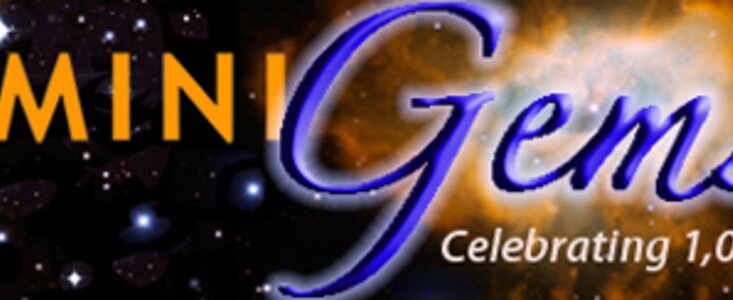Gemini Observatory Celebrates 1,000th Paper
2 Noviembre 2011
Join in the celebration of Gemini Observatory’s one-thousandth scientific paper by becoming a friend of Gemini on Facebook. There, you can follow along, through the end of 2011, as some of the top science results (and dozens of stunning images) from the twin 8-meter telescopes are featured each week in “Gemini Gems.”
The one-thousandth paper, a recent discovery of unidentified material between stars in the center of the Milky Way Galaxy is the “tip of a scientific iceberg” according to Gemini Observatory’s director Dr. Fred Chaffee. “This latest result is typical of the new and exciting ways astronomers explore the universe with the 8-meter Gemini telescopes,” he said. “Findings like this inspire us and we look forward to the next thousand papers to come.”
Gemini astronomer Tom Geballe led the research team that made the observations and wrote the paper, published in the November 2nd electronic edition of the journal Nature. The team reports the discovery of thirteen new members of what are called diffuse interstellar bands (DIBs). The new bands were found while the team was observing stars near the center of our galaxy. “These are the longest-wavelength DIBs known,” said Geballe.
DIBs are formed by the absorption of light by molecules in interstellar space lying between a distant light source and us. While many interstellar absorptions have been associated with specific molecules, the identification of molecules associated with DIBs has stumped scientists since the first examples were reported some 90 years ago.
“We believe that the new absorptions actually occur in the Galactic center,” said Geballe. “Our accidental discovery of them is significant because of the long wavelengths of these DIBs and because we now know that the molecules producing DIBs can exist in a much harsher environment than where they have been previously found.”
Notas
Gemini is grateful to the user community for finding innovative and exciting ways to explore the universe with the twin Gemini 8-meter telescopes. The staff of the observatory is looking forward to the next thousand papers.
Más Información
For more details on this work see the press release from the Rochester Institute of Technology and November 2, 2011 electronic edition of the journal Nature.
Enlaces
- For more details on this work see the press release from the Rochester Institute of Technology and November 2, 2011 electronic edition of the journal Nature
- A listing of some of the most significant findings from Gemini can also be found at: http://www.gemini.edu/sciops/releases.
Contactos
Peter Michaud
Gemini Observatory
Hilo, HI 96720
Tel: 1 (808) 974-2510
Cel: 1(808) 936-6643
Correo electrónico: pmichaud@gemini.edu
Thomas Geballe
Gemini Observatory
Hilo, HI 96720
Tel: Office: +1 (808) 974-2519
Correo electrónico: tgeballe@gemini.edu
Nancy Levenson
Gemini Observatory
La Serena, Chile
Tel: Office: +56 (51) 205603
Correo electrónico: nlevenson@gemini.edu


